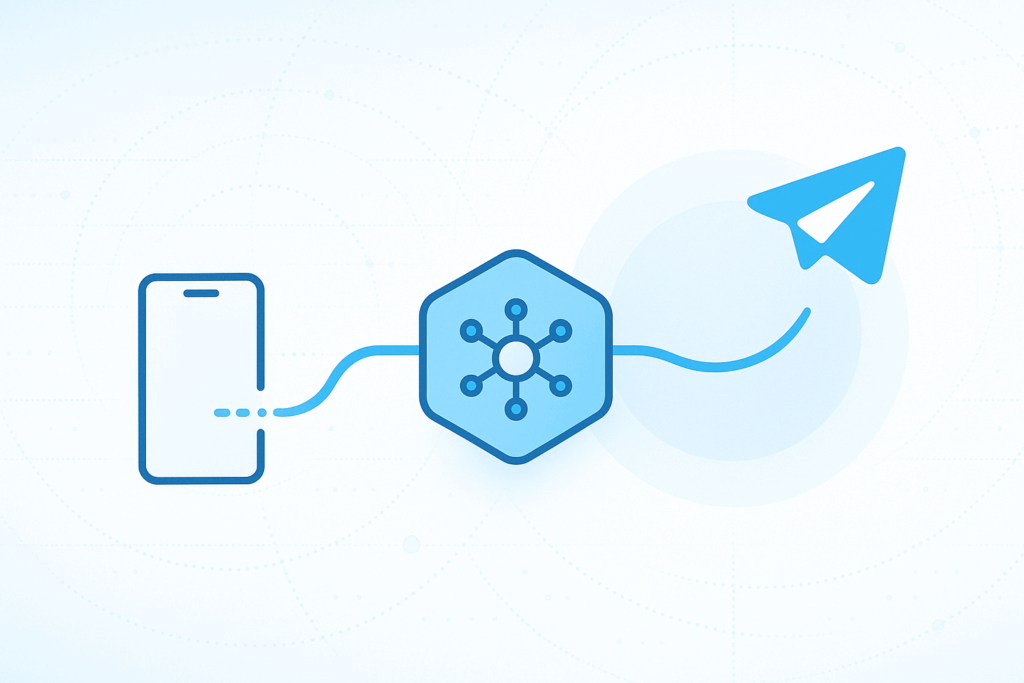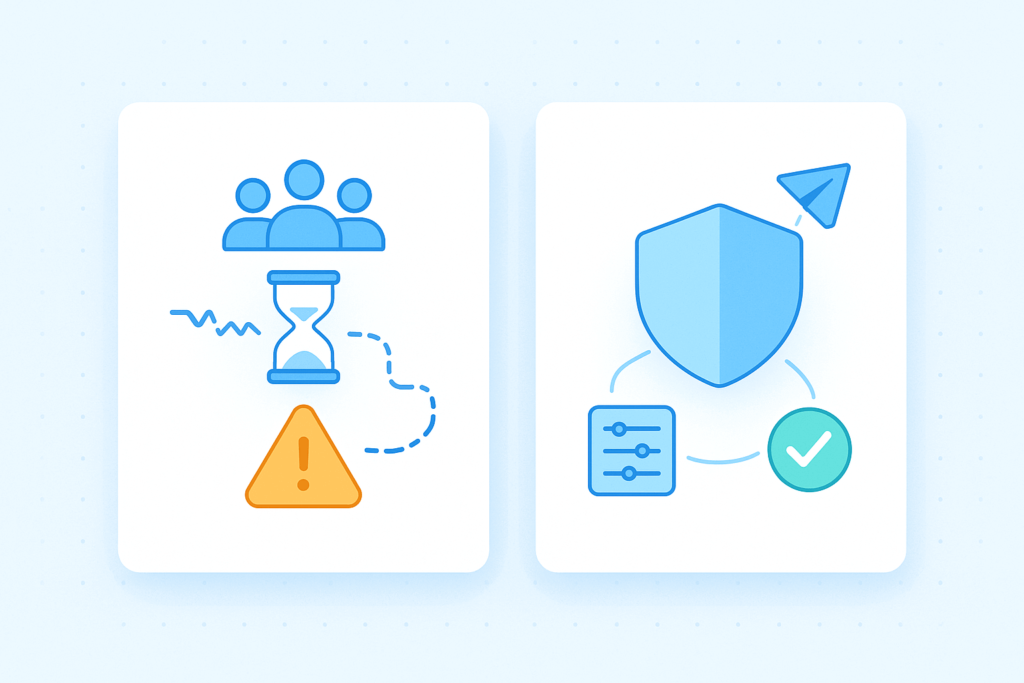Proxy for TG: what is it, how to choose and configure
25 Aug 2025
Reading time ~ 9 mins

A proxy is an intermediate server for connecting to Telegram during blocking, changing IP geography, and increasing stability. A practical basic choice is SOCKS5: it is easy to set up and suits most scenarios. Enabling takes less than a minute: on a smartphone — “Settings → Data and memory → Proxy → Add”, on a computer — “Settings → Additional → Network and proxy”. For reliable operation, take paid pools of the required type: residential IP addresses are suitable for the “home trace”, mobile residential networks are suitable for capricious mobile networks, and provider IPs (ISP) are suitable for static and “clean” ranges.
- A proxy is needed when access is limited, the required geolocation is required, or you work with several accounts.
- Quick start: select SOCKS5, enter the server and port, save the settings – the connection status will be displayed immediately.
- For better speed, select the closest geo and keep a backup server in case of overload.
- The proxy does not encrypt all device traffic; for sensitive tasks, use the appropriate messenger security settings.
What is a proxy in Telegram in simple terms
A proxy is an intermediate node through which the messenger connection passes. The application sees its IP address instead of yours, and the route to the servers is built through this node. This helps to bypass network restrictions, select the desired geolocation and reduce the risk of mass restrictions when working with multiple accounts.
What is important to understand:
- a proxy changes the route and IP for the messenger, but does not encrypt all device traffic;
- affects only the Telegram connection, and not other applications;
- correct choice of geo and address type directly affects speed and stability.
When is this really useful:
- access to the messenger is limited by the provider, in the office network or on a trip;
- you need a “home” geolocation for local chats, channels and services;
- you separate personal and work sessions, minimizing mutual influence.
If the terminology is new, take a look at the quick reference guide – it covers the basics and types of addresses: what is a proxy – simple and to the point..
Types of proxies for Telegram: what to choose
In terms of protocol, SOCKS5 is most often used in the messenger. It provides a stable connection and flexible authorization – this is enough for most scenarios. HTTP(S) also works, but is less common due to application limitations. There is an alternative protocol, but this is a niche option with limited compatibility, so we will not focus on it in this article.
A short cheat sheet on protocols
| Protokol | When suitable | Pluses | Restrictions |
| SOCKS5 | Daily chats, media, calls, working with multiple accounts | Wide support, authorization, speed | Requires correct server/port settings |
| HTTP(S) | Simple scenarios when only proxy traffic is needed | Easy configuration | Less frequently supported, may be less stable |
IP type: behavior and risks
- Residential (home trace). Closer to real users, better perceived by services. For tasks where naturalness is important – you can see the list of locations in your personal account.
- Mobile (operator networks). More tolerant of frequent reconnections and unstable conditions – mobile IP pools are suitable.
- ISP (provider blocks). Static and “clean” ranges – appropriate for long sessions and fixed IP (we will mention in more detail in the selection section).
- Data center. The most affordable and fastest in price / performance, but sometimes “recognizable” by services – suitable for technical tasks and basic correspondence.
If you need a working proxy server for telegram without unnecessary surprises, the starting combination is SOCKS5 + a suitable IP type (depending on the scenario and geography).
Where to get a working proxy: free or from a provider

There are two ways: take an address from a public list or apply for access in Prosox. The choice depends on the task and acceptable risks.
- Public/free lists
Pros: fast and free; sometimes access “in one click”.
Cons: instability (addresses are overloaded and often “die”), the same IP for thousands of people, getting into block lists, speed drops, no support. Suitable only for a one-time access check or as a temporary “patch”.
- Prosox solutions
Pros: guaranteed geo and IP type, clear authorization, control panel and replacement, support, the ability to reserve and rotate, predictable performance. The obvious disadvantage is that it is paid.
It is easiest to start with data center addresses – a good balance of price and speed: look at data center proxies. If statics and “clean” ranges are important, take a closer look at provider subnets (ISP). For intensive scenarios, a plan with unlimited traffic will come in handy.
To check the price and understand which package covers your load, open the pricing plans.
How to enable proxy in Telegram (SOCKS5)
Android
- Open Settings → Data and storage → Proxy.
- Switch Use proxy → Add proxy.
- Type: SOCKS5. Enter Server (IP/domain) and Port; if necessary, enter login and password.
- Save and make sure the status is “Connected”. For stability, add a second node to the backup.
iOS
- Go to Settings → Data and storage → Proxy.
- Enable proxy and click Add proxy.
- Select SOCKS5, specify server and port; if necessary, authentication.
- Save changes and check sending messages/media.
Desktop (Windows/macOS/Linux)
- Open Settings → Advanced → Network and proxy.
- Activate proxy, select SOCKS5.
- Specify IP/domain, port, login/password if necessary.
- Save. When working with several tasks, create a second profile in case of overloads.
Connection via link. If you have a link like t.me/proxy?…, click it in the application and confirm adding — the parameters will be substituted automatically.
Mini diagnostics
- Does not connect. Check the type (SOCKS5), IP/port and authorization data; try another node from your results.
- Slow or floating delays. Change the geo closer to you, use an alternative port from the list, keep a backup server.
- Special requirements. If you need traffic according to the sixth version of the protocol, use IPv6 addresses — they are available in the IPv6 solutions package. For tasks in mobile networks, cellular ranges with frequent address changes are suitable — see mobile residential pools.
Useful practices
- Keep a backup server in the list — switching takes seconds.
- Fix “working” links of IP type + geo + port for reuse.
- For specific address requirements, use the sixth version of the protocol – the option with residential IPv6 helps to close rare cases.
How to choose a solution for a task
Make a choice based on your scenario: first the goal and restrictions, then the protocol (SOCKS5) and IP type.
| Scenario | What to take | Why |
| Personal communication, chats, media | data center | Best speed for a reasonable budget, easy start |
| Need a natural trail, local services, neat multi-accounting | standard residential or unlimited residential plans | Natural addresses, less false triggers; unlimited – for high load |
| Frequent reconnections, travel, unstable networks | mobile residential | More tolerant of connection dynamics and mobile network limitations |
| Long sessions with static address, “clean” ranges | static ISP | Predictability, good network reputation, convenient for pinned sessions |
| Protocol version 6 addresses required | IPv6 for residential networks | Closes niche cases, additional ranges and routes |
| Need maximum speed on a limited budget | data center IP addresses | High throughput and low latency |
Tip: Start with the minimum package, test your geo and load, then scale up.
Security and privacy
A proxy helps you connect and provide the required IP, but it is not a VPN replacement or an “invisibility cloak.” It affects the messenger connection, but does not encrypt all device traffic. Within the app, end-to-end encryption only works in secret chats; regular cloud chats are encrypted differently.
Practical recommendations
- Enable two-step verification (password to log in) and protect the app with a code/biometrics.
- Regularly check active sessions (on the devices tab) and terminate unnecessary ones.
- Separate contexts: personal and work tasks — different profiles and different proxies/IP types.
- Avoid public “free” lists for permanent work: unstable and unpredictable.
- Use SOCKS5 with authentication, store logins/passwords safely, do not repeat them in other services.
- Update your app and OS, do not follow dubious links, be careful with third-party bots.
- Comply with legal requirements and platform rules – a proxy does not cancel the user’s responsibility.

FAQ
- Where to enable proxy in the application?
On a smartphone: “Settings → Data and memory → Proxy → Add”. On a computer: “Settings → Additional → Network and proxy”. Select SOCKS5, enter the server and port, save. - How to understand that the proxy is “working” and fast?
Check the ping in the settings, send a couple of media and make a short call. Stable ping and fast delivery are a sign of normal load. If it “slows down”, change the geo or IP type – data center addresses are more often suitable for speed. - What to choose for everyday communication – data center or residential?
For correspondence and media on a limited budget, data center ones are convenient. If the naturalness of the trace is important, take residential ones. - I need a static, “clean” IP. What will do?
Choose ISP proxies: they are predictable and convenient for constant static sessions. - I often connect from a mobile network and when traveling. Is there a relevant solution?
Yes, use mobile residential ones: they handle frequent reconnections better.
Results and next step
A proxy solves a practical problem: stable access and the required IP without unnecessary risks. The basic support is SOCKS5; then the address type matches your scenario and the node proximity is important.
Signs that the configuration was successful
- The connection is maintained without interruptions during working sessions.
- Media is sent without noticeable delays, voice calls do not “fall apart”.
- Ping is stable (stability is more important than one-time peaks).
- No bursts of additional checks during normal use.
How to scale
- Have an alternative node from another subsegment/geo for seamless switching.
- Record the working “IP type + geo + port” bundle and use it as a template.
- Conduct a short audit once every few weeks: check delays and the relevance of addresses for your load.
Would you like a customized quote?
If you need technical advice or have a specific enquiry, please contact us.
